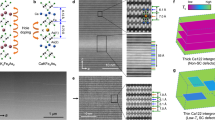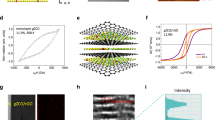Abstract
Understanding the mechanism of ferromagnetism in carbon-based materials, which contain only s and p electrons in contrast to traditional ferromagnets based on 3d or 4f electrons, is challenging. Here, we demonstrate direct evidence for ferromagnetic order locally at defect structures in highly oriented pyrolytic graphite (HOPG) with magnetic force microscopy and in bulk magnetization measurements at room temperature. Magnetic impurities have been excluded as the origin of the magnetic signal. The observed ferromagnetism has been attributed to originate from localized electron states at grain boundaries of HOPG, forming two-dimensional arrays of point defects. The theoretical value of the magnetic ordering temperature based on weak interlayer coupling and/or magnetic anisotropy is comparable to the experimental value. The unusual chemical environment of defects bonded in graphitic networks can reveal the role of the s and p electrons, creating new routes for spin transport in carbon-based materials.
This is a preview of subscription content, access via your institution
Access options
Subscribe to this journal
Receive 12 print issues and online access
$209.00 per year
only $17.42 per issue
Buy this article
- Purchase on Springer Link
- Instant access to full article PDF
Prices may be subject to local taxes which are calculated during checkout




Similar content being viewed by others
References
Mombrú, A. W. et al. Multilevel ferromagnetic behavior of room-temperature bulk magnetic graphite. Phys. Rev. B 71, 100404(R) (2005).
Esquinazi, P. et al. Induced magnetic ordering by proton irradiation in graphite. Phys. Rev. Lett. 91, 227201 (2003).
Esquinazi, P. et al. Ferromagnetism in oriented graphite samples. Phys. Rev. B 66, 024429 (2002).
Esquinazi, P. & Höhne, R. Magnetism in carbon structures. J. Magn. Magn. Mater. 290–291, 20–27 (2005).
Makarova, T. L. et al. Magnetic carbon. Nature 413, 716–718 (2001); see however Retraction: Nature 440, 707 (2006).
Rode, A. V. et al. Unconventional magnetism in all-carbon nanofoam. Phys. Rev. B 70, 054407 (2004).
Ohldag, H. et al. π-electron ferromagnetism in metal-free carbon probed by soft X-ray dichroism. Phys. Rev. Lett. 98, 187204 (2007).
Talapatra, S. et al. Irradiation-induced magnetism in carbon nanostructures. Phys. Rev. Lett. 95, 097201 (2005).
Ovchinnikov, A. A. & Spector, V. N. Organic ferromagnets. Synth. Mater. 27, B615–B624 (1988).
Park, N. et al. Magnetism in all-carbon nanostructures with negative Gaussian curvature. Phys. Rev. Lett. 91, 237204 (2003).
Fujita, M., Wakabayashi, K., Nakada, K. & Kusakabe, K. Peculiar localized state at zigzag graphite edge. J. Phys. Soc. Jpn 65, 1920–1923 (1996).
Son, Y.-W., Cohen, M. L. & Louie, S. G. Half-metallic graphene nanoribbons. Nature 444, 347–349 (2006).
Yazyev, O. V. & Katsnelson, M. I. Magnetic correlations at graphene edges: Basis for novel spintronics devices. Phys. Rev. Lett. 100, 047209 (2008).
Lehtinen, P. O. et al. Irradiation-induced magnetism in graphite: A density functional study. Phys. Rev. Lett. 93, 187202 (2004).
Yazyev, O. V. & Helm, L. Defect-induced magnetism in graphene. Phys. Rev. B 75, 125408 (2007).
Yazyev, O. V. Magnetism in disordered graphene and irradiated graphite. Phys. Rev. Lett. 101, 37203 (2008).
Faccio, R. et al. Magnetism induced by single carbon vacancies in a three-dimensional graphitic network. Phys. Rev. B 77, 035416 (2008).
Kopelevich, Y., Esquinazi, P., Torres, J. H. S. & Moehlecke, S. Ferromagnetic- and superconducting-like behavior of graphite. J. Low. Temp. Phys. 119, 691–702 (2000).
Coey, J. M. D., Venkatesan, M., Fitzgerald, C. B., Douvalis, A. P. & Sanders, I. S. Ferromagnetism of a graphite nodule from the Canyon Diablo meteorite. Nature 420, 156–159 (2002).
Červenka, J. & Flipse, C. F. J. The role of defects on the electronic structure of a graphite surface. J. Phys. Conf. Ser. 61, 190–194 (2007).
Červenka, J. & Flipse, C. F. J. Structural and electronic properties of grain boundaries in graphite: Planes of periodically distributed point defects. Phys. Rev. B 79, 195429 (2009).
Kebe, T. & Carl, A. Calibration of magnetic force microscopy tips by using nanoscale current-carrying parallel wires. J. Appl. Phys. 95, 775–792 (2004).
Lu, Y. et al. Electrostatic force microscopy on oriented graphite surfaces: Coexistence of insulating and conducting behaviors. Phys. Rev. Lett. 97, 076805 (2006).
Kobayashi, Y. et al. Observation of zigzag and armchair edges of graphite using scanning tunneling microscopy and spectroscopy. Phys. Rev. B 71, 193406 (2005).
Niimi, Y. et al. Scanning tunneling microscopy and spectroscopy of the electronic local density of states of graphite surfaces near monoatomic step edges. Phys. Rev. B 73, 085421 (2006).
Kobayashi, Y. et al. Edge state on hydrogen-terminated graphite edges investigated by scanning tunneling microscopy. Phys. Rev. B 73, 125415 (2006).
Niimi, Y., Kambara, H., Matsui, T., Yoshioka, D. & Fukuyama, H. Phys. Rev. Lett. 97, 236804 (2006).
Peres, N. M. R., Guinea, F. & Neto, A. H. C. Electronic properties of disordered two-dimensional carbon. Phys. Rev. B 73, 125411 (2006).
Vozmediano, M. A. H., Lopez-Sancho, M. P., Stauber, T. & Guinea, F. Local defects and ferromagnetism in graphene layers. Phys. Rev. B 72, 155121 (2005).
Wehling, T. O. et al. Local electronic signatures of impurity states in graphene. Phys. Rev. B 75, 125425 (2007).
Kumazaki, H. & Hirashima, D. S. Tight-binding study of nonmagnetic-defect-induced magnetism in graphene. Fyz. Nizk. Temp. 34, 1025–1032 (2008).
Allenspach, R. Ultrathin films: Magnetism on the microscopic scale. J. Magn. Magn. Mater. 129, 160–185 (1994).
Pedreschi, F., Sturm, J. M., O’Mahony, J. D. & Flipse, C. F. J. Magnetic force microscopy and simulations of colloidal iron nanoparticles. J. Appl. Phys. 94, 3446–3450 (2003).
Wagoner, G. Spin resonance of charge carriers in graphite. Phys. Rev. 118, 647–653 (1960).
Irkhin, V. Y., Katanin, A. A. & Katsnelson, M. I. Self-consistent spin-wave theory of layered Heisenberg magnets. Phys. Rev. B 60, 1082–1099 (1999).
Acknowledgements
We are very grateful to R. Lavrijsen for SQUID measurements, P. H. A. Mutsaers for PIXE analysis and H. H. Brongersma for LEIS measurements. We thank B. Koopmans and H. J. M. Swagten for fruitful discussions and comments on the manuscript. This research was supported by Nanoned.
Author information
Authors and Affiliations
Contributions
J.C. carried out the experiments and wrote the paper. J.C. and C.F.J.F. designed and coordinated the experiments. M.I.K carried out the theoretical modelling. All authors discussed the results, analysed the data and commented on the manuscript.
Corresponding author
Supplementary information
Supplementary Information
Supplementary Information (PDF 328 kb)
Rights and permissions
About this article
Cite this article
Červenka, J., Katsnelson, M. & Flipse, C. Room-temperature ferromagnetism in graphite driven by two-dimensional networks of point defects. Nature Phys 5, 840–844 (2009). https://doi.org/10.1038/nphys1399
Received:
Accepted:
Published:
Issue Date:
DOI: https://doi.org/10.1038/nphys1399
This article is cited by
-
Thermal quantum correlations and teleportation in a graphene sheet
Applied Physics B (2023)
-
Defect spinel oxides for electrocatalytic reduction reactions
Nano Research (2023)
-
WI3 Monolayer: Electronic Band Structure and Magnetic Anisotropy Under an External Electric Field
Journal of Electronic Materials (2023)
-
Ferromagnetism in sp2 carbon
Nano Research (2023)
-
Electromagnetic shielding effectiveness and microwave properties of expanded graphite-ionic liquid co-doped PVDF
Journal of Materials Science: Materials in Electronics (2023)



